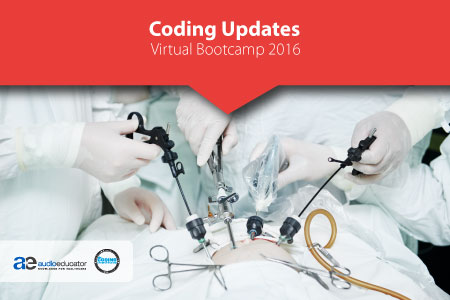With robotic-assistance, laparoscopic surgeons obtain technical advantages that include visual enhancements, dexterity and ergonomics. At first, customers may think they need a new code to report a laparoscopic procedure completed with robotic-assistance, however the fact is that they do not. The American Medical Association (AMA) determines that there was no need for a new CPT or unique modifier for surgical procedures completed with robotic-assistance. As a result, the majority of leading payers, such as a Medicare, CIGNA, United Healthcare and most BlueCross BlueShield plans, consider robotic-assistance incidental to the primary surgical procedure and not separately billable.
Coding Considerations
With robotic-assistance, the primary surgical procedure remains a laparoscopic procedure. There are many new CPT® codes used for billing these services, but unfortunately, many of the frequently performed laparoscopic/robotic procedures do not have specific procedure CPT® codes. New guidelines have been developed by the AUA for coding robotic complete cystectomy codes which robotic procedures do not have specific CPT® codes for. Lets look at some common urology codes to keep in mind.
| CPT® | Description |
| Urology | |
| 50543 | Laparoscopic, surgical; partial nephrectomy |
| 50544 | Laparoscopy surgical; pyeloplasty |
| 55866 | Laparoscopy, surgical prostatectomy, retropubic radical, including nerve sparing; includes robotic assistance, when performed |
| 51999 | Unlisted laparoscopy procedure, bladder |
Reimbursement Considerations
Routine and customary coding will result in routine and customary reimbursement consistent with the payer’s current contract terms. Numerous MS-DRG and Ambulatory Payment Classification (APC) assignments are possible and dependent upon the primary surgical procedure reported by the hospital. Common MS-DRGs and APCs include, but are not limited to:
| MS-DRG | Description |
| 328 | Stomach, esophageal and duodenal procedure without CC/MCC |
| 331 | Major small and large bowel procedures without CC/MCC |
| 346 | Minor small and large bowel procedure without CC/MCC |
| 419 | Laparoscopic cholecystectomy without C.D.E. without CC/MCC |
| 655 | Major bladder procedures without CC/MCC |
| 661 | Kidney and ureter procedures for non-neoplasm without CC/MCC |
| 664 | Minor bladder procedures without CC/MCC |
| 664 | Minor bladder procedures without CC/MCC |
For more on coding for Laparoscopic and Robotic procedures, take part in the year’s biggest virtual boot camp on coding updates – Virtual Boot Camp. This session will be presented by renowned coding expert Dr. Michael A. Ferragamo Jr. This conference will review these new codes and guidelines as well as provide specific tools, coding tips, and the knowledge to properly bill and code to ensure correct and entitled payments of all laparoscopic/robotic procedures. To help meet these objectives, specific coding clinical scenarios will be used to help clarify these coding principles. Coding of radical and simple robotic nephrectomies will be discussed as well as coding for robotic radical prostatectomy or simple robotic prostatectomy.




